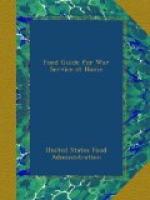The Individual’s Part in Fat Conservation. Although at present there is butter and lard on the market, the need for conserving it is important, just as in the case of meat. WASTE OF ANY KIND SHOULD BE ABHORRENT TO ALL OF US AT THIS TIME. There probably has been a greater waste of fat than of any other commodity, but it is encouraging to note that this waste has been decreased by conservation. The amount of fat in city garbage has gone down all over the country. In Columbus, Ohio, the fat in the garbage was almost 50 per cent less in 1917 than in 1916. In fourteen large cities with a total population of over 5,000,000 nearly 40 per cent less fat was recovered in March, 1918, than in March, 1917.
Not only can fat be saved by carefully avoiding every bit of waste, but less can actually be used. FRY FOOD LESS, AND BAKE, BROIL, OR BOIL THEM MORE. USE VEGETABLE OILS. In a long view of the food situation, it is the animal fats that cause gravest concern, because of the years necessary to build up a herd. WE MUST SEND AS MUCH FAT ABROAD AS POSSIBLE, AND CREATE RESERVES FOR PERIODS OF SHORTAGE WITH A MINIMUM DEPLETION OF OUR HERDS.
CHAPTER VI
SUGAR
OF ALL THE FOODS WHICH IT IS NECESSARY TO CONSERVE, SUGAR IS THE EASIEST TO DO WITHOUT. If the war and what it means has become part of a person’s consciousness, he wishes only the bare essentials. Sugar is a luxury of former times which has become a commonplace to-day. The average use in the United States was 83 pounds per person last year—1-2/3 pounds a week—less than one hundred years ago the yearly consumption was 9 pounds. Sugar was a rare luxury. It will do no harm to regard it so again.
WHY IS THERE A SUGAR SHORTAGE?
Sugar is scarce for two reasons—much less beet-sugar is actually being grown, and some of the cane-sugar is too far away to be available. The sugar-beet, grown in temperate climates, and the sugar-cane, native in tropical and semitropical regions, are the only two sources of sugar large enough to be of more than local importance.
Before the war, 93 per cent of the entire world crop of beet-sugar was grown in Europe. The industry was started by Napoleon in the early nineteenth century when he was at war with most of Europe, and France was shut off from her supply of cane-sugar from the West Indies. The industry spread over the great plain of Central Europe, from the north of France over Belgium, Germany, Austria-Hungary to Central Russia. In 1914 all of these countries were producing enough sugar for their own needs. England produced none at all, but the continent, especially Germany and Austria, supplied her with about 54 per cent of what she needed.
[Illustration: MAP SHOWING LOCATION OF EUROPEAN BEET SUGAR FACTORIES—ALSO BATTLE LINES AT CLOSE OF 1916
ESTIMATED THAT ONE-THIRD OF WORLD’S PROOUCTION BEFORE THE WAR WAS PRODUCED WITHIN BATTLE LINES]




